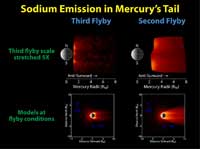|
COMETS EARTH JUPITER KUIPER BELT MARS MERCURY METEORITES NEPTUNE OORT CLOUD PLUTO SATURN SOLAR SYSTEM SPACE SUN URANUS VENUS ORDER PRINTS
PHOTO CATEGORIES SCIENCEVIEWS AMERICAN INDIAN AMPHIBIANS BIRDS BUGS FINE ART FOSSILS THE ISLANDS HISTORICAL PHOTOS MAMMALS OTHER PARKS PLANTS RELIGIOUS REPTILES SCIENCEVIEWS PRINTS
|
Related Documents
Download Options
Comparison of the neutral sodium observed during the second and third Mercury flybys to models. The top left and right panels show the same images as in Image 2.2, but the color scale for the third flyby has been stretched to show the distribution of sodium more clearly. As in previous flybys, the distinct north and south enhancements in the emission that result from material being sputtered from the surface at high latitudes on the dayside are seen. The lower two panels show Monte Carlo models of the sodium abundance in Mercury's exosphere for conditions similar to those during the two flybys. These models illustrate that the "disappearance" of Mercury's neutral sodium tail is consistent with the change in conditions. Observations of the sodium exosphere and tail throughout Mercury's orbit during MESSENGER's orbital mission phase will enable such "seasonal" effects to be studied. Refinement of models similar to these will lead to an improved understanding of the source and loss processes and their variations among Mercury's different exospheric "seasons." Credit: NASA/Johns Hopkins University Applied Physics Laboratory/Carnegie Institution of Washington |
